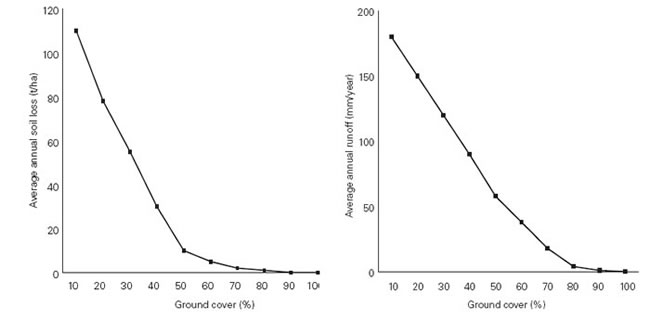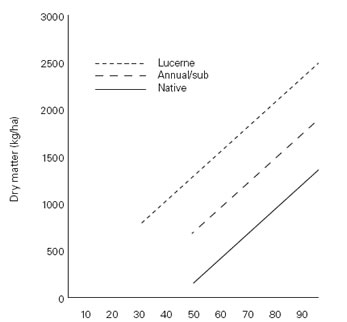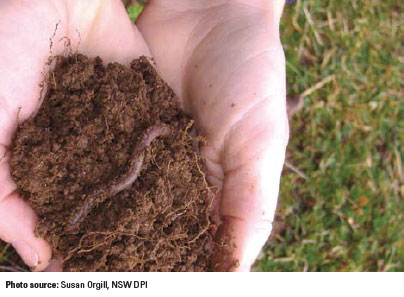|
|
Background
information
In a pasture system, grazing animals account for only about 25% of the living animal tissue in the system. The rest is accounted for by bugs that live in the soil and litter (decomposing plant material that lies on the soil surface). The top 10cm of most soils is particularly rich and contains most of the soil’s nutrients, plant roots and living organisms (bacteria, fungi, protozoa, nematodes, earthworms and other soil animals).
Soil organic matter and the activity of bugs and earthworms that feed on it help improve soil structure and water holding capacity, allowing rainfall to penetrate the soil and be available for plants. As a general rule, a one percentage point increase in soil organic matter increases soil water holding capacity by 12mm.
Groundcover (litter and plants), as well as being a forage source, minimises raindrop impact and loss of water by runoff, reducing soil erosion and nutrient loss. Litter on the soil surface can reduce evaporation by up to 1mm per day. High groundcover levels can also be important in weed control, particularly for thistles and Paterson’s curse, and for reducing the impact of root feeding grubs such as cockchafers and scarabs.
|
|
 |
 |
Maintain groundcover to provide good soil bugs with close to ideal conditions, protect soil from erosion and mimimise water loss
|
 |
Assess groundcover and litter levels at key times and give your soils the ‘look, feel and smell’ test
|
|
 |
Introduction
One mm of topsoil lost by erosion equals about 10 tonnes of soil per hectare. This soil can take thousands of years to be replaced through the weathering of parent material. Where topsoil has been lost through erosion, the only way to restore some of the productive capacity is by building up organic matter from plant and animal residues.
Nutrients are also removed in animal products (meat and wool). In a sustainable system, nutrients removed in animal products need to be replaced to maintain the productivity of the system.
Key decisions, critical actions and benchmarks
All of the biological ‘action’ in the soil relies on providing food together with suitable temperature and moisture conditions. By far the most critical management action which sheep producers can take to protect their soils and ‘keep the soil bugs happy’ is to maintain high levels of groundcover. This is provided by litter, as well as growing and dead plants. The standard benchmark is 70% groundcover (see figures 6.1 and 6.2, and tool 6.2).
Maintain groundcover
A minimum of 70% groundcover is the accepted benchmark for the high rainfall zone except for sloping country where close to 100% is needed. For the lower-rainfall wheat–sheep zone, where annual pastures dominate, equivalent benchmark values have not been established, but they may be lower than those for higher rainfall areas.
Ground cover protects soil, encourages microbial activity and increases water holding capacity in soils.
Soil organic matter levels are influenced by management, climate and soil type, making it almost impossible to set target levels, but for soil health, more is always better. Generally, woodland maintains higher organic matter than pastures and pastures are higher than land cultivated for crops. Procedure 8.2 in Turn Pasture into Product has tips for maintaining ground cover with grazing.

Figure 6.1: In the medium to high rainfall zones of eastern Australian, maintaining 70% groundcover can minimise both run-off and soil loss (Lang, RD (1998). Pasture management for both production and stability. Australian Society of Agronomy).

Figure 6.2: There is a strong relationship between available dry matter and groundcover (Lang, RD (1998). Pasture management for both production and stability. Australian Society of Agronomy).
Attracting good soil bugs
- Litter (or mulch) not only helps protect the soil from wind, rain and temperature extremes, it is also the main food source for soil organisms. Litter quality is just as important for the bugs as pasture quality is for grazing animals. Highly digestible, high protein feed is readily consumed and the nutrients recycled but it takes much longer for dead, fibrous stems and leaves to break down and be recycled. When the bugs die, nutrients (such as nitrogen, phosphorus, potassium, and sulphur) are released and become available again for plant growth
- Fertile soils: increasing soil fertility generally increases both pasture growth and quality, which leads to more and better quality litter and, therefore, more of the ‘good soil bugs’ with increased activity.
Earthworms are a good indicator that soil conditions are suitable for microorganisms. Sample moist soil at the end of winter / early spring. In the high rainfall zone, more than 10 earthworms per spadeful (20cm by 20cm by 10cm deep) indicates an active biological system — that is a stocking rate of more than 2.5 million earthworms per hectare. An earthy smell is also a good indicator as this suggests active and healthy actinomycetes (beneficial soil bacteria).
Soil conditions to avoid
- Soil temperatures above 25°C or below 15°C: it is impossible to keep the soil temperature always in this range, but a good litter layer can help
- Dryness: most soil micro-organisms live permanently in the water film around soil particles and like their food moist
- Regular cultivation physically disturbs the soil and reduces soil microbe levels by decreasing aggregate stability and depleting organic matter
- Overgrazing and compaction reduce soil health and can starve the bugs of much needed food, reducing their activity and therefore the rate at which nutrients are recycled
- Burning destroys litter and reduces soil organic matter
- Waterlogging (as a result of compaction by grazing or cultivating wet soils or sodicity) can reduce the oxygen content of soil, slowing the rate of organic matter decomposition
- Acid soils: like plants, the preferred range for most micro-organisms is pH 6 to 7
- Some chemicals: herbicides generally have less impact on soil organisms than insecticides, which, in turn, are less harmful than fungicides and nematicides. Most microbes tolerate herbicides with few persistent effects. However, simazine, 2,4-D, paraquat, diquat and MCPA can be more harmful than glyphosate and sulphonyl ureas. Anti-parasitic drenches can have an adverse effect on organisms that first colonise affected dung, but over the entire year the overall effect should be small.
Signposts  |
Read
The MLA Pasture Health Kit: a field kit for producers to assess pasture health in the paddock. The kit can be ordered from MLA by:
Soil Biological Fertility: a Key to Sustainable Land Use in Agriculture (2003). L.K. Abbott and D.V. Murphy (Springer).
The Biology of Soil: a Community and Ecosystem Approach (2005). R.D. Bardgett (Oxford University Press: New York).
Soil Biology in Pasture Systems – Knowledge and Opportunity Audit: a summary of research into the types and function of soil organisms and their interactions in the soil food web under pasture systems. Download a copy here (1MB).
View
MLA Tips & Tools: a large number of titles including: the MLA pasture ruler, earthworms, soil health and groundcover. Get your free copies of these MLA Tips & Tools by:
Soil Biology Basics: individual fact sheets on soil biology and agriculture. Visit: www.dpi.nsw.gov.au/ and search for soil biology basics
Living Soils: find out more about the living things in soil and what they do. Visit the University of New England website: http://openlearning.une.edu.au/LivingSoils/
Soil Health: provides background information relevant to soil health and the sustainable use of land for agriculture, horticulture and other practices, including forestry. Visit: www.soilhealth.com
Soil Quality: the USDA Natural Resources Conservation Service web site with a wide array of information about all aspects of soil health. Visit: www.soils.usda.gov/sqi/
Soil Quality: use the tools on this website to better understand soil health. Visit: www.soilquality.org.au
Dung Beetles: for a good overview of the role and biology of dung beetles, including resources for each state Visit: www.dungbeetle.com.au/
Sustainable grazing - a producer resource, explains how grazing management techniques can be used to achieve increased productivity and reduced methane emissions per hectare. There are 5 sections to this online resource:
- Running a sustainable grazing business
- Climate variability - using water wisely
- Healthy fertile soils
- Productive persistent and profitable pastures
- Grazing management
Visit: www.mla.com.au/research-and-development/environment-sustainability/sustainable-grazing-a-producer-resource
Australian Soil Resource Information System: ASRIS provides online access to the best publicly available information on soil and land resources in a consistent format across Australia It provides information at seven different scales:
- The upper three scales provide general descriptions of soil types, landforms and regolith across the continent.
- The lower scales provide more detailed information in regions where mapping is complete. Information related to soil depth, water storage, permeability, fertility, carbon and erodibility.
- The lowest scale consists of a soil profile database with fully characterised sites that are known to be representative of significant areas and environments.
Visit: www.asris.csiro.au/index.html
Attend
The MLA EDGEnetwork® program is coordinated nationally and has a range of workshops to assist sheep producers. Contact can be made via:
|

|